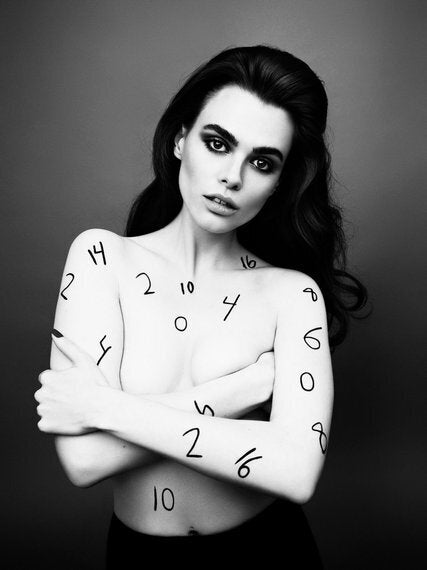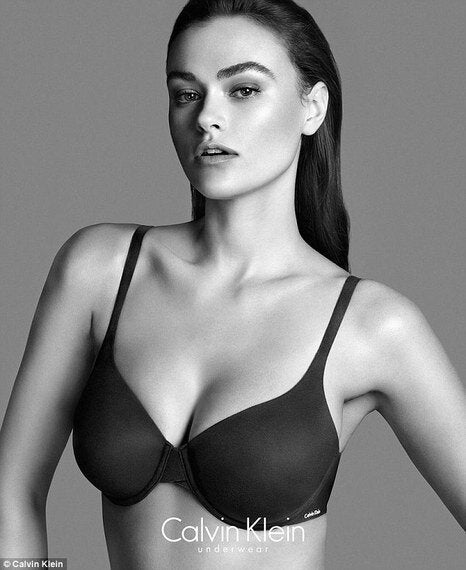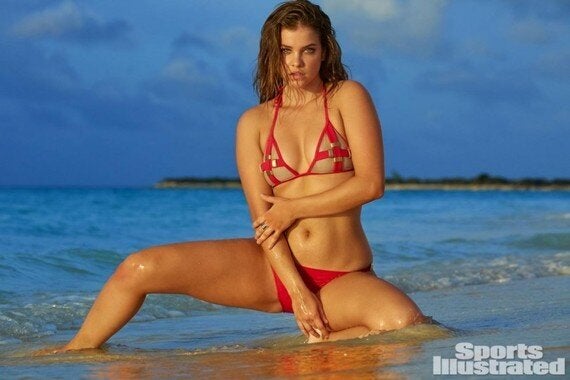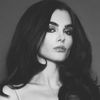As a female model, you become perpetually aware of your body changing throughout the month. Some days, you're bigger than others; your face less defined, more round. Other days, you're thinner, and your clothes hang off you in ways they didn't previously. My hip measurements can vary two sizes in the space of a day, yet my dress size pretty much remains consistent. Despite that, those little two inches can make the biggest difference to a client with a measuring tape.
Bar monthly hormonal changes, I'm sure if you aren't a model, the changes in your body aren't that noticeable. But, as a model, you're more in tune with your body than ever before. Knowing your body inside out is a blessing, but also a head-fuck: you can only control your body's fluctuations so far.
So, I guess I'm now considered an 'inbetween' model. I'm lucky, because unlike a lot of girls, I'm represented by an agency, Muse, who are willing to push me (and other girls) at the size I'm at. I'm healthy and happy and it shows. They encourage me to the best version of myself, rather than forcing me to change or to diet. My agent, Trudi, is especially supportive of my body shape and the struggles I've had with it before. I truly see it as a blessing that I'm getting to do a job I love, all whilst being myself.
But while Muse are forward-thinking in their approach, many agencies have yet to tap into that inbetween market. If they have, it often appears they choose to represent girls that have a famous surname, or girls who have already established themselves on the fashion scene.

A lot of modeling agencies simply don't know what to do with an unknown model who doesn't fit in the straight or plus categories. Girls are either straight or curve, and nothing in-between. That means a lot of stunning girls with model potential are being overlooked, simply because of a few extra centimeters.
What people often don't realize is that, if sit in the middle of these categories, you're encouraged to fit into one category or the other. It's not unusual for some girls to wear padding to appear "bigger" for some clients; or, if you fit into the smaller end of the scale, you're expected to do what you can to be thinner.
The inbetween debate is made more difficult when you consider plus-size models are referred to as the 'real' women of the modeling industry. What message does that send out to young women? HELLO: ALL women are real, models included, and it's about time we represented each and every one of them.
Inbetweeners represent more than just a group of models. They represent millions of normal women who feel inadequate - the 6's, the 8's, the 10's - who feel that fashion doesn't include them, or makes them feel they need to change in order to feel 'beautiful'.
The irony is that there are plenty of beautiful models willing to fill that gap; models who'd love nothing more than to not change their diet and to feel comfortable in their true sizes. I've had messages from plenty of them wishing they could. It's just that the fashion industry isn't doing enough to fill that void with them. Whilst we will always want models to fit size-0 couture clothes and curve models to fit the plus-size market, there will always be a gap for models in the middle.
It's not just agencies that hold the responsibility of being more representative of size - the whole fashion industry is responsible for being the change we want to see. The pattern cutters can cut bigger sizes for the catwalk; the photographers and casting directors can hire girls of middle sizes. Representing women of all sizes does not mean fashion loses its appeal, glamour or grandeur. It just makes it fair for everyone to enjoy.

In 2014, model Myla Dalbesio fronted Calvin Klein's campaign, the same campaign that launched the careers of Kate Moss and Brooke Shields. At the time, she was 27 and a US size 8/UK size 12 - not 'eligible' for the plus-size category, but not skinny enough for the straight-sized category, either. "I can never figure out where I fit in," she said at the time. "I'm not skinny-skinny, but I'm not fat and fabulous either."
Her curves caused controversy in the fashion industry, leading the media to describe her as "Calvin Klein's First Plus-Size Model". Curve models couldn't believe she was being described as plus-size, finding it an insult to their profession. Myla couldn't believe that at her size, she was being compared to plus-size models. Either way, by simply being herself, she couldn't win.
At the time, Calvin Klein didn't bring attention to the fact they hired an "inbetween girl", releasing her images as they did the other women in that campaign. Choosing her at the size she was wasn't a big deal, because guess what - it's not a big deal. And it never should've been.
Their choice of casting was a breath of fresh air for models everywhere. Myla wasn't born into a famous family like the Hadid's or Jenner's, with a surname to back her up. She was a working model plucked from obscurity, chosen for her beauty and individuality, just like models should be.
To me, the fact a huge brand was willing to pick a girl for her beauty rather than her fame, frame and age, says to me the industry's willing and open to progress - that it's on its way to representing a variety of beauty. But considering this campaign is already two years old, I only wish more big brands had taken note and followed suit in that time.
However, Myla's just one inbetweener in the spotlight for her size. 22 year-old supermodel, Barbara Palvin, hit headlines recently for two reasons: the fact she was one of few lucky models being featured in the Sports Illustrated's Swimwear issue, and the fact she was deemed "fat" by people on the internet for how she looked in it.

It's fairly clear that Barbara isn't plus-size in the slightest. Yes, she's curvy, but the word "curve" does not equate to "fat" - no matter how much the media has tricked us into thinking it does.
We've rammed the idea of thinness so far down society's throats, that young women can't dictate what's healthy anymore. And half the reason 'normal' women aren't being represented in fashion, is because the same, 'normal' women think models of their own size are too big. Does that not prove how warped society has become towards female bodies?
Curves are a by-side of being a female: even the smallest size 2 girls can have them. And it's about time we embraced all variations of curves, rather than just associating plus-size girls with them. Do we honestly want another generation of women being raised to feel inadequate and misrepresented with body image issues?
Modeling should not be inclusive to size. Beauty comes in a host of shapes, heights and colours. And when brands choose inbetween models to front their campaigns, its not only an exciting development for the modeling industry, but also a step forward in body-positivity.
So let's stop segregating models by their measurements. Let's stop letting hip sizes dictate whether someone is model-worthy or not. Let's start finding more Maya's and Barbara's, and bring modeling back to what it's best at: discovering charismatic, unique and beautiful faces, that all women can aspire to.
